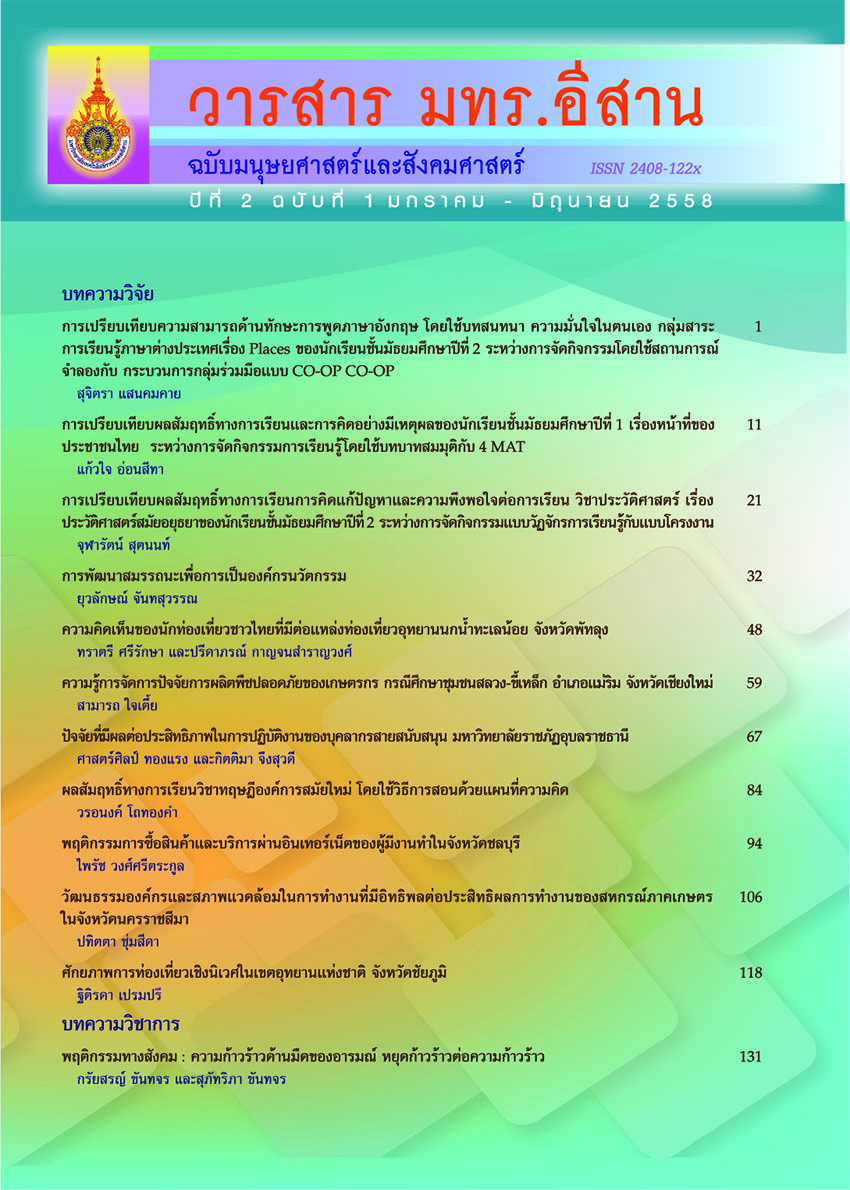The Development Models of Cultural Learning Resource by using Community Participation : Nakha Sub-District, Wapipathum District, Maha Sarakham Province
Main Article Content
Abstract
The aims of this research are 1) to study current situations and problems, and 2) to study development models of cultural learning resources by suitable community participation to local. This was the Research and Development (R&D), which adapted the Action Learning (AL) and Participatory Action Research (PAR). Research was separated into three periods, which were the first phase was document study, related research, and defined research framework, the second phase was selection of village target, and the third phase was creation of the model’s cultural resource learning development by the tentative conceptual model, after that brought to test with research target area. Research instruments for collecting data were observation, interview, focus group discussion, Before Action Review (BAR), After Action Review (AAR), workshop, and activity report. Research areas were: Bann Dongyang village Moo 3, and Bann Namuang village Moo 14, Nakha sub-district, Wapipathum district, Maha Sarakham province. Purposive sampling method was used for sampling collecting, which was 70 people, so that number were included 20 people of key informants, 30 people of casual informants, and 20 people of general informants. Researching duration started from September 2012 to September 2014. Document analysis, there studied from involving document and field studied, and using the analytic induction method. The research result found as the following: 1. Current problem issues were found that the research sites have got a temples being as a community center, beliefs were inherited from their ancestors, and important culture that related to Buddhism. There are events all the year, which call “Heat Sipsong Kong Sipsee”. In addition, there were five groups, which involved with the development of cultural learning resource. Those were Bann Dongyang village such as a group of reed mat weaving, and a group of agricultural professionals, also Bann Namuang village such as a silk weaving group, a basket - weaving group, and a group of agricultural professionals. However, they did not concomitant uses the development models of cultural learning resource with their developing. 2. The development models of cultural learning resource by community participation, so that created the development model by used a tentative conceptual model, also applied five processes of Action Leaning (AL), and six processes of Participatory Action Research (PAR). From those two approaches could create fourteen events of action learning activities, after that experimentation with the research areas. As a result of those activities, it were found a new groups that from: a cotton - weaving group was established one more group from an original target group at Bann Namuang village. Furthermore, fourteen of practical learning activities are increases to seventeen activities, which were a budget seeking activity and supporting sector, activity of making a knowledge brochures, and creating a network of cultural activities. In conclusion, development models of cultural learning resource need to rely on learning process, which from action learning and community participation for doing activities, so that consistent with wisdom, lifestyle, and public needs of people in that area. In order to changing an actual condition area that appropriately appropriateness to bring the country’s development, which are equilibrium, consistency, and further sustainability.
Article Details
บทความที่ได้รับการตีพิมพ์เป็นลิขสิทธิ์ของมหาวิทยาลัยเทคโนโลยีราชมงคลอีสาน
ข้อความที่ปรากฏในบทความแต่ละเรื่องในวารสารวิชาการเล่มนี้เป็นความคิดเห็นส่วนตัวของผู้เขียนแต่ละท่านไม่เกี่ยวข้องกับมหาวิทยาลัยเทคโนโลยีราชมงคลอีสานและคณาจารย์ท่านอื่นๆในมหาวิทยาลัยฯ แต่อย่างใด ความรับผิดชอบองค์ประกอบทั้งหมดของบทความแต่ละเรื่องเป็นของผู้เขียนแต่ละท่าน หากมีความผิดพลาดใดๆ ผู้เขียนแต่ละท่านจะรับผิดชอบบทความของตนเองแต่ผู้เดียว
References
Chantarasombat, C. (2008). Participatory Action Research for Community Development. Maha Sarakham : Apichat Karnpim
Chantarasombat, C. Singkaew T. Arsatong P. and Singporn R. (2010). Innovation for the development of village self-sufficient economy, community-based
Wangjan Nakha sub-district, Wapipathum district. Maha Sarakham province. Maha Sarakham : Apichat Karnpim
Luepanya, C. (2012). Participatory Model between School and Community in Developing Sufficiency Economic Learning Center Case Study Nakha sub-district,
Wapipathum district, Maha Sarakham Province. M.Ed. Education, Mahasarakham University of Maha Sarakham
Ministry of Culture. (2009). Master plan of national culture 2007-2016. Bangkok : Office of the Permanent Secretary
Pratumchat, C. (2010). The Development of a Knowledge Management Model of Khum Kham Community Learning Center, Amphoe Si Chiang Mai, Changwat
Nong Khai. M.Ed. Education, Mahasarakham University of Maha Sarakham
Sudsanguan, N. (1992). The anthropological research. Bangkok : Chulalongkorn University Bookshop
Wansiri, N. (1997). Social and Cultural Anthropology. Bangkok : Kasetsart University
Wasi, P. (2002). Knowledge Management. Workshop to draft pilot projects on knowledge management 27 July 2002. Kanchanaburi


